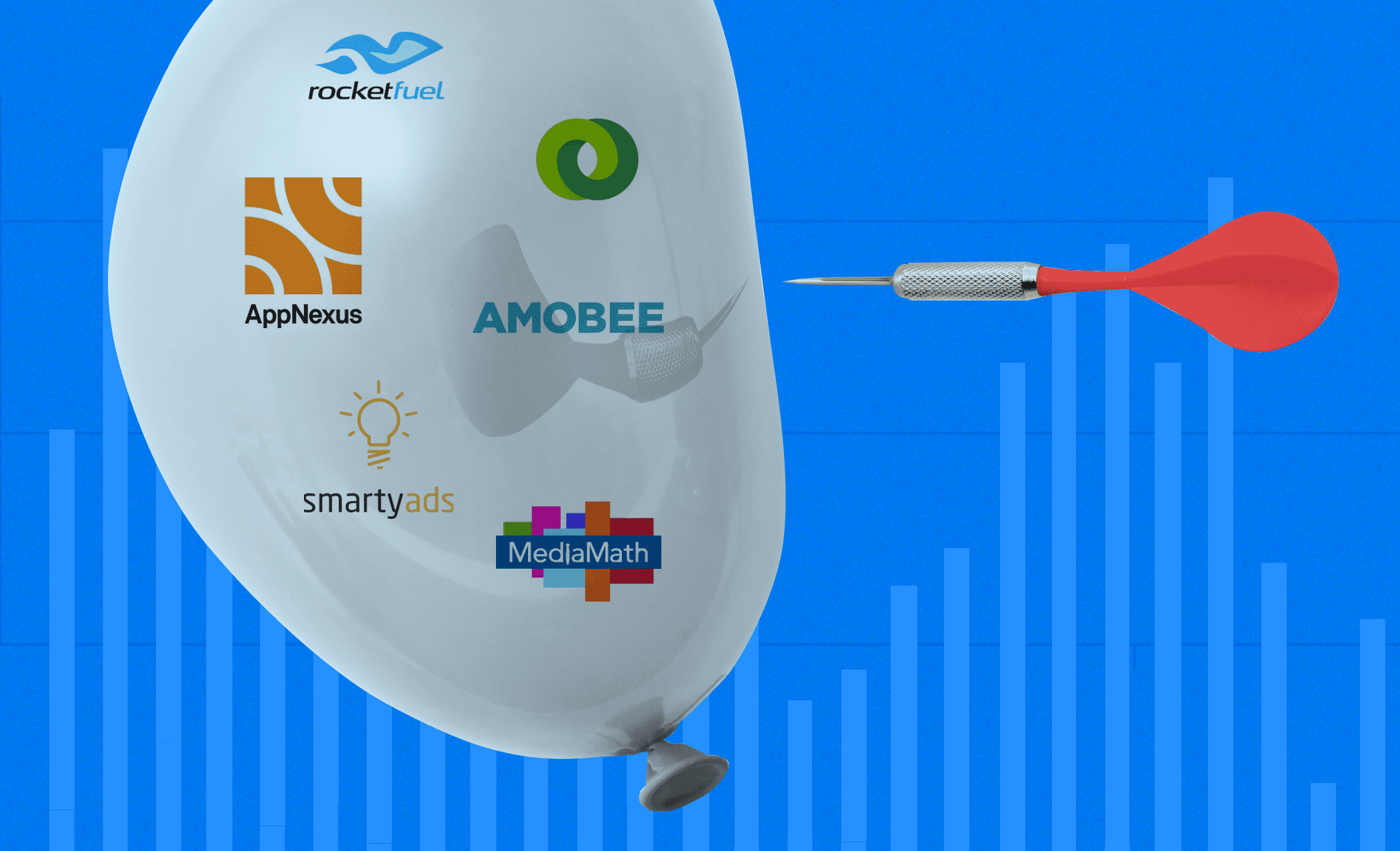Ad tech is experiencing a sense of deja vu these days. Between historical valuations, bidding wars, and last-ditch efforts to flip businesses, it all feels very 2013.
It’s been eight years since the last ad tech bubble ballooned, then burst, and yet, all seems to have been forgiven and forgotten. Not only are ad tech companies red-hot with investors right now, but they’re also gaining steam amongst one another. As a result, deals are being cut left and right at an unabating pace.
So what’s driving ad tech’s latest consolidation wave?
Strategic Opportunism in Ad Tech
A moment of this magnitude is rare for an industry like ad tech, especially given its history of being shrugged off repeatedly by investors. It comes down to several moving parts aligning perfectly with one another.
Online ad spending has accelerated, and valuations for ad tech companies are at an all-time high, creating renewed interest in ad tech amongst private equity and strategic investors. The cherry on top? Capital is cheap. Combine every ingredient, and there is a lot of cash flowing around ad tech companies right now.
Just last month, Verve Group, a network of ad tech companies, acquired LKQD, a mobile video ad platform, from the telecommunications company Nexstar. According to Verve Group’s Chief Revenue Officer Sameer Sondhi, “the conditions in the market right now mean it’s a great opportunity for further consolidations.”
Additionally, the neglect of ad tech companies has only fueled the flames for them to take advantage of these markets to create entities that scale. Sondhi adds, “it’s a positive shift for the industry at large, moving from a fragmented landscape toward more holistic, integrated companies which, ultimately, brands and advertisers can benefit from.”
Is This Bubble any Different?
With interest rates so low, it feels as if money is in abundance. So is this the making of another ad tech bubble? Ad tech executives are praying otherwise.
When the last ad tech bubble burst, it went out with a bang, triggering an almost decade-long hiatus. The firms who struggled amidst the burst had to sell, and venture capital investors shied away from making further investments after not seeing the returns they were hoping for. This time, investors and strategic buyers are paying attention. Still, no one truly knows what will happen for the ad tech market and the newly-minted ad tech companies, even with laser-focused eyes. Order to understand whether ad tech is due for a correction requires sifting through ad spending forecasts and tracking the velocity of money. At this point, it is unclear which direction it is all trending.
One thing is for sure: the most significant difference between then and now is that ad tech companies are positioning themselves as software-as-a-service businesses, even if they are often still paid as a percentage of the media dollars spent through their tech.
Historically, investors have always been partial to the predictability of SaaS pricing. Amazon and Google have made beaucoup profits from this model, with advertising dollars propping it all up. That’s why investors are doing valuations and looking to attract media dollars in ad tech firms. And the research backs this up: GroupM expects global advertising to grow by 19% (excluding U.S. political advertising) during 2021, a significant upward revision from their December forecast.
Two Reasons Why the Boom is Happening
Merging to reduce the marginal cost of production
One move straight out of the vertical integration playbook that has picked up steam is the merging of entities to reduce the marginal cost of production. The two latest companies to run this play are LiftOff and Vungle.
Following majority investments from private equity funds managed by Blackstone, both companies are merging into one entity, Liftoff+Vungle. Their immediate goal is to consolidate in-app spending. Their long-term goal is to cement themselves as one of the largest independent ad tech companies in mobile advertising. Doing so could secure an influx of media dollars circulating through both businesses.
LiftOff delivers two billion engaging ads each day across more than 500,000 mobile apps in more than 140 countries. In addition, Vungle has over 100,000 direct SFK integrations across leading mobile app publishers and 15,000 individual content creators across their influencer marketing platform, as well as services across content analytics and user acquisition.
Research documents in the AlphaSense platform point to a rise in Supply Side Platforms (SSP), technology platforms that enable web publishers and digital out-of-home media owners to manage their advertising inventory, fill it with advertisements and receive revenue. This tracks perfectly with the Liftoff+Vungle merger. Their union seeks efficiency benefits from operating across both the demand and supply side of in-app ad spending: LiftOff helps those with mobile apps identify, grow, and retain their audiences through user acquisition and retargeting campaigns. At the same time, Vungle connects advertisers with mobile app publishers looking to monetize their apps.
Building a content fortress
The term content fortress was championed by Eric Seufert, the mobile game marketing strategist and thought leader behind the Mobile Dev Memo Blog. He defines this as a platform or portfolio of products supported by a rich advertising ecosystem that serves an owned and operated inventory using predominantly first-party data.
But why is a content fortress so appealing right now for ad tech?
Back in May, Apple implemented its new App Tracking Transparency (ATT) policy through iOS 14.6. ATT is a key part of Apple’s privacy roadmap. This privacy roadmap solidifies Apple as the gatekeeper of iPhone services. ATT resulted in Apple’s identifier for advertisers (IDFA) becoming explicitly opt-in for every single app.
Since June, the effectiveness of advertising has dropped significantly, resulting in declines in cost per mile (CPM), a form of ad pricing on iOS. In addition, this depreciation of IDFA has demolished the ability of advertisers to personalize advertisements due to limitations in third-party data to target users. In essence, the value of third-party data has depreciated, and the importance of first-party data has increased.
Companies that can own their marketing ecosystem and enable first-party data collection and usage have a distinct advantage. These companies can operate content fortresses, incorporating content and user interactions into their properties. AppLovin is an excellent example of this. They are pursuing acquisition strategies centered on building out an advertising ecosystem to sell space across their inventory. This allows them to disentangle themselves from reliance on mobile identifiers owned by Apple or any other business looking to profit from granular tracking.
Investor Interest in Ad Tech Has Yet to Wane
No one wants to miss out on the speculative goodness of blank-check companies and out-of-this-world valuations. In a capital-flooded market, many investors push on despite contraction fears. When economic policies remain loose, there is always money to be had. Even private investors, who have steered clear of ad tech in the past, are beaming with promise over the sector’s future.
The real question becomes: will these ad tech players be able to deliver consistent earnings? After all, ad tech is a volatile market where transparency into finances has always been murky. Nevertheless, ad tech climbed these mountainous feats in 2013, and when the bubble burst in 2015, it was the straw that broke the camel’s back for investors to write off the sector.
Then again, these are unprecedented times. Unlike before, the world weathered a pandemic in 2020, meaning the stakes are much higher now. Between vaccinations, the rise in the Delta variant, pent-up spending demand, lower interest rates, and wage increases, there is a good chance the economy will continue on its current role for a while.
There is no doubt that the way the sector makes money will change over the next few years. In the latest wave of consolidations, ad tech is coming full circle. Companies built to flourish in a fragmented landscape are having to go back to the drawing board. Like the ad networks that drove the ad tech’s early success, companies need to cater to both the buy and sell sides of the market. What once was old is now new.




